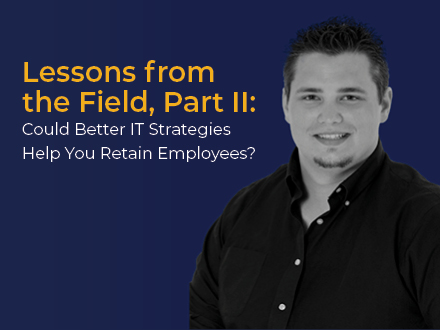Lessons from the Field, Part II: Could Better IT Strategies Help You Retain Employees?
By James Keiser, Director of Secured Managed Services Southeast, CISO Global, Inc.
While a number of organizations have moved back to an in-person work model, some employees are pushing back and leaving for jobs that will allow them to work from home (WFH). Having become accustomed to the advantages of a WFH model, employees have a lower tolerance for inconveniences like time and money spent on commutes, being away from loved ones for long hours, packing lunches, and having to dress for an office environment. In fact, 4 million people left their roles in February 2023 alone, signaling that if employers want to stop “the great resignation”, they will need to address all issues that may be causing people to feel a lack of connection and empathy at work – including their work model. According to HR specialist ClearStar, “An employer who accommodates their employees with remote work… and shows interest in trying to help them find something they enjoy doing in their job is likely to build a relationship with their employees that they are not so quick to abandon.”

Working models can have serious implications not only for employee retention rates, but IT infrastructure. While business leaders and their teams sort out in-office vs. hybrid vs. WFH, IT teams are left guessing at how to engineer an environment that supports the entire company’s needs and creates a roadmap. One thing I emphasize with clients is the wisdom of taking an approach that doesn’t build their IT environment around a single work model. The more flexible and secure their technology is, the faster they can respond as corporate policies change over time – or vary from employee to employee.
Flexibility Wins Every Time
Key tenets of a flexible environment work around the following concepts: cybersecurity that follows users everywhere – no matter where or when they are using company assets, secure access to corporate tools and data, collaboration enablement, resilient architecture, well-trained users, and scalability.
This checklist will ensure your employees are empowered to work from any location needed, while keeping company assets secure.
What You Need to Make Flexibility Your Reality
Remote Access and Virtual Desktop Infrastructure (VDI): Implement secure remote access solutions, such as VPNs or VDI, to allow employees to securely access corporate networks and resources from their home environments. VDI provides a virtualized desktop environment that can be accessed remotely, ensuring data remains within the organization’s secure infrastructure.
Collaboration Tools: Collaboration is essential to modern business models. Make sure your toolset enables teams to be effective and stay connected without relying on email threads. Microsoft Teams, Planner, Trello, and numerous other platforms can be useful, depending on your needs for file storage, project tracking, etc. Video conferencing tools will also help your teams to stay connected, collaborate on projects, and share information effectively.
Use Cloud-Based Applications: Cloud-based software applications and services help ensure that your teams have everything they need to do their work, no matter where they are. Cloud apps can be accessed remotely from any location with an internet connection. Cloud solutions allow your employees to work on shared documents, access business applications, and store data securely in the cloud.
Cybersecurity for Endpoints: Implementing robust endpoint security measures to protect devices used by remote workers will include human-directed, behavior-based, managed detection and response (MDR) 24/7 for all endpoints; up-to-date and well-managed firewalls (these can lose effectiveness over time if not routinely updated and tightened down); device encryption; and staying current on patch management.
Note: if you cannot implement MDR, antivirus software (AV) should be installed as the bare minimum. AV will not protect you as well as MDR, but it’s still better than nothing.
User Support and Training: Providing employees with the necessary support and training to effectively navigate remote work challenges. This includes offering technical assistance, guidelines for setting up secure home office environments, and educating employees about best practices and security protocols for remote work.
IT is Business Enablement
Ultimately, it should be a priority that your IT program is integrated into your business strategy. Make sure your infrastructure is assessed regularly, not only for security gaps that may develop over time, but also for efficiency. Make sure you are supporting the felt needs of all stakeholders. Expert guides can be helpful in this process, because they are looking at your environment objectively and can give you a big-picture view of how well your existing setup is aligned to help the organization meet its business goals. Further, they can bring you the perspective that only comes from having assessed hundreds of other environments just like yours. They will be able to anticipate needs, identify security issues, and pinpoint potential compliance problems faster, simply due to their level of experience.
To talk with someone about securely building more flexibility into your IT environment, we’d like to hear from you. You can request a consultation with any of our experts, and we’ll help you think through your challenges, as well as possible solutions.